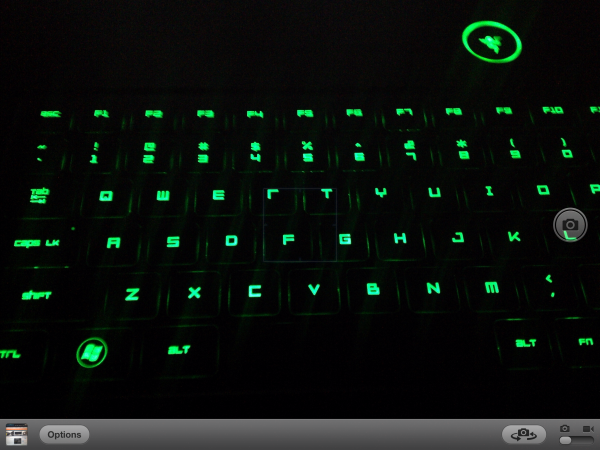The Apple iPad Review (2012)
by Vivek Gowri & Anand Lal Shimpi on March 28, 2012 3:14 PM ESTThe Camera, It's Much Improved
by Vivek Gowri
iOS 5.1 brought with it a number of bugfixes along with a few minor changes to the core entertainment applications (Music, Photos, Videos), but the only real UI change it brought was the redesigned camera application for the iPad. It fixes our biggest complaint with the original—the shutter button’s location in the middle of the settings bar at the bottom of the screen—and ends up being a big improvement from a usability standpoint. The shutter now resides in a floating circular button on the right side of the display, right where your right thumb falls when holding the iPad with two hands. It’s a more intuitive location for the shutter, so taking a picture is a far more natural feeling exercise than it was before. Other than that, the app looks pretty similar—the settings bar now has the still/video slider, front/rear camera switch, an options button, and the link to the photo gallery.
In terms of camera options, there’s only one. You can either have the rule of thirds grid overlay visible or hidden....and that’s it. There’s no other settings for you to change. No exposure, white balance, ISO, shutter speed, or anything else that isn’t the shutter button. Unfortunately, even the HDR mode from the 4 and 4S is nowhere to be found on the iPad. You literally just point and shoot. That’s all there is for you to do.
In our review of the iPad 2, we summed up the cameras with just one word, mediocre. Looking back, I realize now that the word mediocre is a pretty charitable way to describe the iPad 2’s camera situation. Both sensors were borrowed from the iPod touch, and while the VGA front facing camera was acceptable, the rear facing 720p camera was legitimately bad by the standards of a $499 device.
The new iPad fixes that rear camera problem in a big way, with the five element f/2.4 lens and optics borrowed from the iPhone 4S paired with the Omnivision OV5650 CMOS image sensor from the iPhone 4. A quick refresher on specs: 5 megapixels, backside illuminated, 1080p video at 60fps. If you ignore megapixel count, it’s a pretty competitive camera on paper. There’s a lot of recycled parts here, with bits and pieces from other iDevices frankensteined together to come up with a new imaging system for the iPad, but parts-bin raids aren’t bad when the bins being raided from contain top-tier components. The result ends up being pretty good—as a camera, the new iPad is light years ahead of its predecessor in basically every way.
In practice, it’s nothing short of stellar. Image quality is comparable to most high end smartphones, though not quite good enough to be on par with the bleeding edge cameraphones (4S, Nokia N8/N9, HTC Amaze 4G, Galaxy S 2, etc). Interestingly enough, the preview image looks to be running below 30 fps, appearing a little bit choppy at times. This is likely due to the high resolution of the preview and upscaling it to a very high display resolution, but it doesn’t particularly affect image capture. I measured shot to shot time at exactly one second (I had a range between 0.98 and 1.04 seconds, averaged out to 1.0 when factoring in reaction time). That’s about double what Apple claimed for the 4S, and a bit longer than the iPad 2. Granted, the iPad 2’s camera was very quick in part because the amount of processing it takes to capture a 960x720 image is almost zero, with about 13.8% as many pixels as each 2592x1936 image captured by the new iPad.
The focal length is 4.28mm, a bit longer than the iPad 2’s 3.85mm. The difference is actually noticeable; when taking pictures of nearby subjects, you’re sometimes surprised by how magnified the subject appears. However, the camera is good for landscapes, as you can see from the sample gallery. I took the iPad with me on a weekend trip to Victoria, B.C. and used it as my primary camera on the trip. Now, while I wouldn’t trade my SLR for an iPad anytime soon, I can’t deny that the results turned out pretty well. Colours were vibrant, white balance was accurate, and the clouds were nicely highlighted. It’s a quantum leap from the noisy, 0.7MP mess that was the iPad 2 camera. Mouse over the links below to see some comparisons between the cameras on the iPad 2, 3rd gen iPad and TF Prime.

| Apple iPad 2 | Apple iPad (3rd gen) | ASUS TF Prime |
| original | original | original |

| Apple iPad 2 | Apple iPad (3rd gen) | ASUS TF Prime |
| original | original | original |
The new sensor can record 1080p video, up from 720p. Video quality was probably the best aspect of the iPad 2 camera, and it's even better here. Output is recorded at 29.970 fps and encoded in h.264 Baseline with a bitrate of 21Mbps and single channel audio at 64kbps. The recorded video impresses, with crisp detailing and adequate audio quality from the single mic.
The front facing camera keeps the Omnivision OV297AA sensor from the iPad 2, and as such, image and video quality remain unchanged. It’s not necessarily a bad thing, since it remains adequate for FaceTime and Skype, but it would have been nice to see an update to an HD-quality webcam up front.
With augmented reality apps, I’m starting to see the benefit of rear cameras on tablets. For example, the Yelp app, which takes location and compass data to display what restaurants are the direction the iPad is pointing, with a real-time street view of the search results. It’s not necessarily the most useful way to use the rear facing camera in an AR application, but overall it’s an idea that has potential. Apple also tells us that its business and education customers see usefulness in the iPad's rear facing camera as they can use it to quickly document something while using the iPad as a productivity tool. As a consumer, you’re going to get weird looks if you’re using the iPad to take pictures though, it’s a relatively comical sight.
And that’s really the problem: from an ergonomic standpoint, smartphones are just so much easier and more comfortable to use as cameras. And because the imaging hardware is so similar, I’m not sure I see the real benefit of having a rear facing camera on a tablet except in very specific use cases.

























234 Comments
View All Comments
Jamezrp - Wednesday, March 28, 2012 - link
Didn't want to cause Verizon too much trouble? Heh, very funny. I am amazed at how the iPad ends up being an amazingly good Wi-Fi hotspot. It almost seems like business users should opt to get an iPad for that function alone. I know plenty of people who would be happy to keep it in their bag, with the hotspot feature enabled constantly, while travelling about. Even for the price there is nothing even close that can compare.Plus, you know, you get the tablet too.
supertwister - Wednesday, March 28, 2012 - link
"It’s a quantum leap from the noisy, 0.7MP mess that was the iPad 2 camera."Interesting choice of word considering a quantum is the smallest possible division for a quantity...
omion - Wednesday, March 28, 2012 - link
Quantum leap:(n) an abrupt change, sudden increase, or dramatic advance
The phrase comes from the ability of particles to make a sudden jump between two energy levels. It is a leap (of any amount) between two quantization levels, not a leap of the smallest possible amount.
drwho9437 - Wednesday, March 28, 2012 - link
A large fraction of the die doesn't seem to have a known use? Wondering what could be taking up all that area if not GPU, CPU and memory interfaces/caches... Most other I/O would have small footprints...tipoo - Wednesday, March 28, 2012 - link
The 4S had a larger than usual die for its voice cancellation features that were needed to make Siri work well, the iPad does't have that but it does have voice dictation so some space is probably for that.PeteH - Wednesday, March 28, 2012 - link
A big chunk of it is probably the ISP they talked about when the 4S debuted.Lucian Armasu - Wednesday, March 28, 2012 - link
So this is how I assumed. The new iPad is in fact slower than the iPad 2, if games actually start using the 2048x1536 resolution for their apps, which everyone seems to be encouraging them to do. But once they do that the graphics will either look poorer, or they will be slower than they were on the old resolution, even on an iPad 2.Add that to the fact that apps are much bigger in size with the retina resolution, and the CPU is the same as last year. The new display might look great, but it's obvious that the new iPad is absolutely a step-back in terms of performance, whether it's GPU or CPU we're talking about. Hardly worth an upgrade, especially for iPad 2 owners.
xype - Thursday, March 29, 2012 - link
Blah blah blah performance blah not worth it.I don’t give a shit about theoretical performance that I might be getting if DNA folding software was available for tablets. I really, really give a shit about being able to read website and ebook text without my eyes straining after an hour.
One would think that 10 years after "No wireless. Less space than a nomad. Lame." and Apple raking in millions and billions of profit, those Geek Metrics™ that people are so fond of here (nothing wrong with that, it’s interesting stuff!), would be recognized as completely and utterly worthless to the average population. But apparently not.
The iPad was never ment to replace PCs and Consoles as a hardcore gaming device, and it was never ment as a render farm server replacement. It would be really nice if people realized that, at some point. In the next 5 years, perhaps.
tipoo - Thursday, March 29, 2012 - link
It seems a bit like the 3GS-4 transition, it used the same GPU despite higher resolution and so performed worse at native, although in this case the CPU is unchanged and the GPU is "only" 2x better for 4x the pixels. Developers got around that on the 4 by making games for the old resolution and using upscaling mode. I'd imagine they will do the same here once games hit the limits of the GPU at native. Games like Infinity Blade 2 also use separate resolutions for things like the menus vs shadows vs terrain textures.darkcrayon - Thursday, March 29, 2012 - link
I guess if the only thing you bought an iPad for were games, and you could only consider a game to be worthwhile if it were drawn directly at 2048x1536, you'd have a point. But of course the new iPad could play games at the "iPad 2" resolution at much higher detail, or at a slightly resolution with the same detail, etc.It doesn't make sense to say it's a step backward in performance overall- it simply has the option to display much higher resolution graphics that the old model didn't have. The iPad 2 displays 2048 x 1536 text at "0 mhz" so to speak. It's not like you are losing anything by having the option of ultra high resolution if the type of game (or app) can use it within the hardware capabilities.